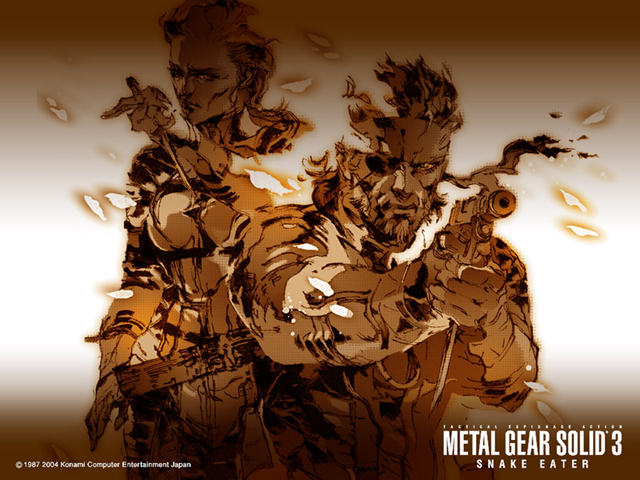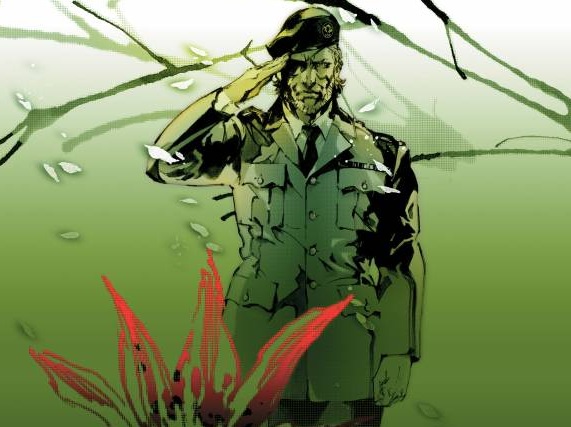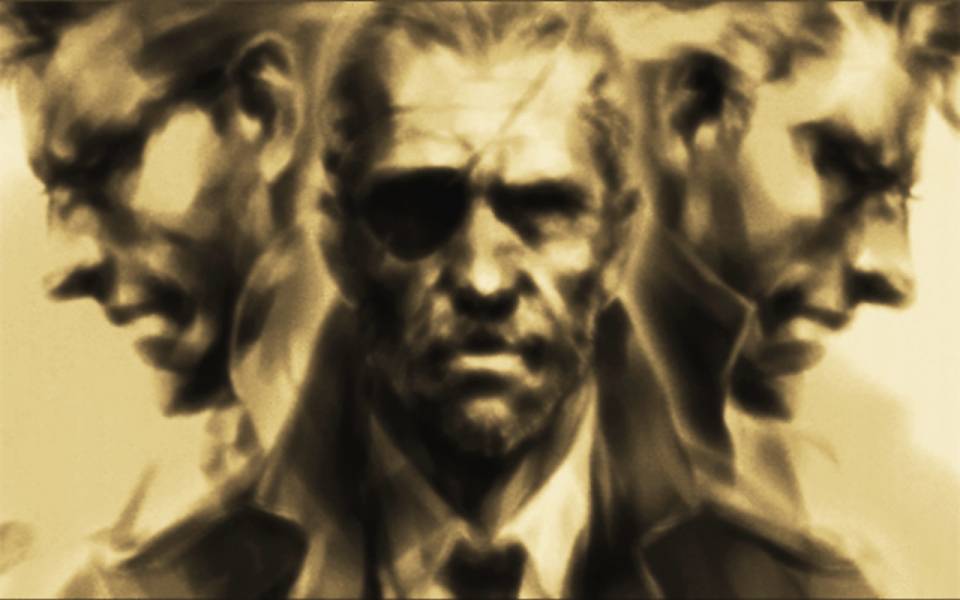Metal Gear Solid Analysis: The Identity Trilogy Part 3: Snake Eater
By Daneian -1 Comments
In the second part of our thematic analysis of the Metal Gear Solid franchise, we took an exhaustive look at the structural subtext of Metal Gear Solid 2: Son’s of Liberty. Starting in that game, a thematic split began to form in the narrative. The story was about the importance of ideas and information to the growth of a single individual but also looked at the interaction of many individuals to form a society. Metal Gear Solid 3 carries it further.

In the decades after World War II, the world was divided. Nations rallied in support of one of two political philosophies each with a different super power as its fountainhead- communist Russia to the East and the capitalist United States to the West. These two countries were equipped with enough nuclear technology to blow the Earth asunder at the smallest provocation- but neither side was completely ready to light the match. The stalemate between these former allies would go down in history as the Cold War.
Under the constant stress of annihilation, fear gripped the citizens of the U.S. Socially, the global rise of communism and paranoia of revolution or government infiltration by its ideology led to the Red Scare, the active hunt for sympathizers within American borders. With neighbor watching neighbor, no one was sure who was patriot and who was spy.
August 1964, above the Soviet Union- an AC-130H ‘Combat Talon’, acting as field command, soars through the sky. Its cargo bay opens and a sole figure jumps into the blazing sun of the breaking dawn. Landing among the lush forests of Tselinoyarsk, he removes his air mask, revealing a shaggy, familiar brown mullet. John Doe radios his ship. A member of the fledgling FOX unit, this master of infiltration and camouflage’s mission is to aid Dr. Nicholai Stephanovich Sokolov, Russian rocket scientist, in defecting to America. Caught in a power struggle for the Soviet Union between Premier Nikita Khrushchev and one of Leonid Brezhnev supporters, Colonel Yevgeny Volgin, Sokolov was building weapons. For this mission, John is appointed the codename Naked Snake.
Luckily, Snake has support. Among them, his former mentor, The Boss. Radiating confidence, ability and pride, The Boss is the legendary World War II soldier and mother of modern special ops. She taught Snake how to fight and developed Close Quarters Combat, a form of hand-to-hand combat. Their relationship is exceeds intimacy. She was Snakes teacher in all the same ways Solid Snake was Raiden’s.
And then she committed treason. Defecting from the U.S., she captures Sokolov from Snake and delivers him, her Cobra Unit and a Davy Crockett infantry-sized nuclear missile system to Volgin. As Snake tries to wrestle with the reality of the situation, The Boss breaks his arm and throws him into the river. The last thing John sees is the nuke The Boss gave to Volgin decimating Sokolov’s Design Bureau.
Operation Snake Eater was born from desperation. In the aftermath of the detonation, Nikita Khrushchev, Premier of the Soviet Union was struggling to hold onto his power. Revolutionary factions within his country viewed the incident as a covert United States attack and were ready to use the incident to oust him from office and unleash World War III. Only by killing Volgin and assassinating The Boss could America prove its innocence and save the planet from disintegration. Snake once again infiltrates Tselinoyarsk.
But he lacks The Boss’ confidence because of the only lesson she never taught him- how to think like a soldier. John is naked, exposed to the world. He is a baby lost in the forest who must defeat the Cobra unit, a group of special Ops members that The Boss assembled during World War 2 based on the emotions that they carry into battle. Each member represent a different emotion derived from the experiences that a soldier feels on the battlefield as it shapes them into who they are. By defeating them, Snake is transcending them, growing.
The Pain of bullets tearing into flesh. Having endured the pain, the body becomes aware of it and aware that it could happen again. Scarred and disfigured, the body’s reluctance to experience it again creates-
The Fear of that pain and the emotional toll of a terror that stalks but can’t be seen; once it infects, its poisons run deep. Fear is invisible and when cloaked in its shroud (his camo) the strength and stamina of its wearer is sapped, which leads to-
The End of life as death comes, never seen. It lies in wait, slumbering until it must take its victims life. Its speed startling and its retreat, deafening. What it leaves in its wake is-
The Fury of having experienced death firsthand and the flaming rage that spurns destruction; the heat engulfing any that come before it. Eventually the fires extinguish, replaced by-
The Sorrow for those who have died by your hand or by your side. Only by facing them, accepting your actions and claiming responsibility for them can you move on. It is living viewing the past through the cracked lens of grief.
This is the course that emotions run through a man who must fight. They are experiences. Snake’s experiences.
And The Joy commands all emotion. It is the fulfillment of knowing what to believe in and what to fight for the rest of your life. But she’s known by another name- The Boss. As Snake stands opposite his mentor, the woman he loved, we know this is their last fight.
But something fascinating is happening. Snake’s mastery of infiltration and camouflage allow him to disappear into the thicket of flowers suffocating the battlefield, but when he reappears behind The Boss, he is engaging her with an expanded technical set he didn’t possess before that moment- he is attacking with new moves, countering ones that he hadn’t been able to before. He is holding his own against the woman who created CQC and had handily laid waste to him over and over since her defection.
And yet, those experiences are exactly why he’s winning now- he’s learned. That’s the theme at the center of Metal Gear Solid 3: Snake Eater. Scene. Most easily understood in its theatrical sense, the concept of scene is the information that is accumulated from interacting within the world, of acting on its stage. Every punch he took, every bullet he removed made him stronger and as Snake stands victorious over The Boss, pointing the gun she gave him at her head, the last experience you have is pulling the trigger. And for averting nuclear war between two super powers, Naked Snake is awarded a promotion- the title of Big Boss.
Big Boss was a soldier loyal to the mission, to the job he was given by his country, one he believed was virtuous. But a soldier is a tool for the government under its employ. Governments are social constructs and a society gains experiences. They grow. Their leaders come and go, generations replace generations and people die. A society’s policies are dictated by the times. But societies interact with others- they have friends, they have enemies and they learn from their dealings. But those, too, are dictated by the times.
Which makes The Boss’ sacrifice all the more tragic. As the medals are pinned to Big Boss’ chest, we learn the real history. The Boss was a true patriot. On orders, she infiltrated Volgin’s ranks to acquire the Philosopher’s Legacy; a $100 billion pool spread all over the world. She was supposed to bring it back to the coffers of the United States, a mission she thought would help lead to a unified world. But then Volgin fired the nuke. The strategy to reclaim the Legacy was revised. In order to settle the extremists in the Soviet Union, the U.S. government now needed to kill its soldier as she was carrying out their orders. But it had to look convincing so had to be done by her most loved disciple Naked Snake. From here we have a manufactured recording of history. The Boss will forever be hated around the world- as monster in Russia and as a traitor in her homeland. It’s information manipulation condensed into plot. And few would know the truth, but John Doe would become stronger.
And it’s here we learn that we’ve been victims of the same affliction since before the first Metal Gear Solid and where the themes of the past two games provide us better understanding of Snake Eater. History is a record; of events and the people who influenced them . It can be manipulated. We know Big Boss, his genes and the stories of his villainy- we believe him to be a monster and terrorist. What is so surprising is that the figure standing tall before us is none of those things. He is a man who is loyal to his ideals and is trying to work for a better world. We realize that he is the same as Solid Snake, they are born from the same mold. The Sons of Liberty taught us the nature of culture and how the stories that are passed on can change the perspective of humanity if the information is filtered and changed. Here we see it directly applied. For many people before Snake Eater’s release, the theories behind GW’s S3 engine had worked; it had corrupted their perception and colored their bias.
Ultimately, Metal Gear Solid 3: Snake Eater is about the beginning; the beginning of the series of events that lead to the present- of the franchise, of the ‘Snakes’ and of the world. We must not blindly hold onto ideals, must not simply adopt the beliefs of our friends and families, can’t take the values and actions of our country at face-value. Instead, we must form our own values based on how we see the world. That was what the Boss wanted for Snake, the witness to the tragedy of the Cobra Unit. Fight for what you believe in, in what the world should be, but fully understand what those beliefs are.

SOLIDARITY
Memes, genes, scene. MGS. Bodies build from a recipe of genetic information. The ingredients dictate not the absolute destiny of the organism but narrows down its potential one. Between the bookend events of its birth and death, it acts within the world and learns from doing so. It meets others, learns the stories of their experiences, discovers music and creates a history.
Many people settle together and form a society. The society propagates a culture and forms a political system to make rules about interacting within. It acts within the world and learns from doing so. Individuals die and the culture evolves. The society changes. It meets others, learns the stories of their experiences. They make friends and trade, they make enemies and fight. The society changes.
The Sons were born clones, but they are no longer duplicates. They are variations of an original- solid, liquid, and solidus objects are variations on matter as Solid, Liquid and Solidus are all variations on Big Boss. Even though his genes have been passed to them, their personalities developed in America, in Britain, in Africa with markedly different experiences. In the end, these men share fewer similarities than their genetic structure might lead to believe. This is precisely why John Doe’s’ heritage is of little importance. In his body were all the parts that made Solid and Liquid, just in a different combination.
That is a legacy. At its core, the Metal Gear Solid series is about what we pass on; the ideas we cultivate and the actions we take that affects the world that the future will exist in. Kojima’s plea comes from each successive Snake and to the next; from Naked to Solid, from Solid to Raiden; from the generation of our grandparents to our children- live life.

This essay and it's companion pieces for The Twin Snake's and Son's of Liberty can also be found on Script Routine.
